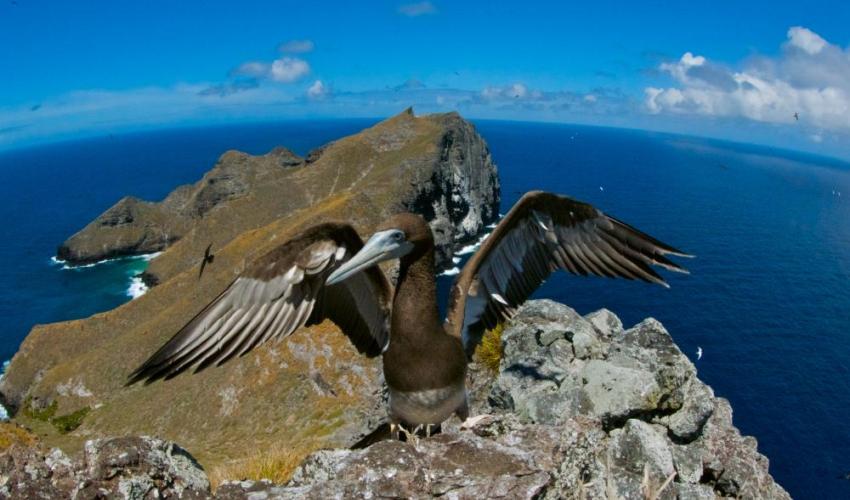Papahānaumokuākea is one of the largest Marine Protected Areas in the world, home to thousands of species and culturally important for Hawaiian people. Here we learn about marine debris removal and habitat restoration initiatives
Papahānaumokuākea Marine National Monument, originally known as the Northwestern Hawaiian Islands Marine National Monument, is the largest protected conservation area in the U.S. and one of the largest Marine Protected Areas (MPAs) in the world. The archipelago spans 362,073 km2 of the Pacific Ocean - an area larger than all the country's national parks combined.
In 2006, a Presidential Proclamation declared the site to be a protected area for both natural and cultural value, signaling a turning point for global conservation policy and opening the door for larger MPAs. In 2010, the Monument was subsequently inscribed as a UNESCO World Heritage Site – one of the only “mixed” natural and cultural World Heritage Sites in the world.
The coral reefs and atolls surrounding Papahānaumokuākea, “the rainforests of the sea”, are home to over 7,000 marine species, one quarter of which are endemic to Papahānaumokuākea. The area is full of important habitats for threatened and endangered species including green turtle and the Hawaiian monk seal, 14 million seabirds, and four endemic land birds including the world’s most endangered duck. Scientists continue to discover new underwater species and richly biodiverse communities during dives and deep-sea explorations.
The impacts of climate change and marine debris to these important habitats and species are evident. “We are at risk of losing species before we even know that they exist,” says Dr. Randall Kosaki, Papahānaumokuākea’s Deputy Superintendent for Field & Research. “The World Heritage site designation provides a spotlight for this.”
In addition to the ecological importance of the archipelago, Papahānaumokuākea has great cultural importance to Native Hawaiians. Papahānaumokuākea, the Hawaiian name of the site, commemorates the union of two Hawaiian deities, Papahānaumoku and Wākea, the creators of the Hawaiian Archipelago and the Hawaiian people. Mokumanamana (also known as Necker Island) has the highest density of sacred sites in Hawai’i and has spiritual significance in Hawaiian cosmology.
“The World Heritage designation draws attention also to its unique natural heritage and to its vulnerability to environmental global threats,” says Dr. Randall Kosaki, Papahānaumokuākea’s Deputy Superintendent for Field & Research.
The site is co-managed by U.S. National Oceanic and Atmospheric Administration (NOAA), U.S. Fish and Wildlife Service, Hawaii State Department of Land and Natural Resources and the Office of Hawaiian Affairs. They are implementing some innovative initiatives to protect the naturally and culturally important site from climate change and marine debris.
For example, an NOAA initiative removes over 45,000 kilograms of plastics and fishing gear from Papahānaumokuākea’s waters each year. Another NOAA program turns the fishing nets into fuel for electricity. On Kure Atoll, Field Station Supervisor Cynthia Vanderlip has lead ecological restoration projects in effort to protect local seabirds.
“We look at ecosystem-wide functions over time,”lsays Vanderlip, “recent major storms have shown the patterns of waves washing ashore and changing vegetation. With that knowledge we can do simple things, like planting perennial naupaka (Scaevola sericea) in low points in the dunes to recover natural structures.”
Every year, six volunteers spend six months on Kure. They eradicate invasive species, plant native species, monitor bird colonies, including Laysan ducks and black-footed albatross (Phoebastria immutabilis, Phoebastria nigripes), among other tasks. Not only does this have positive effects on local ecosystems, it contributes to global environmental progress by engaging youth in ecosystem restoration and habitat protection.
“This crazy site experience amid thousands of seabirds changes your perspective,” says Vanderlip. “We create opportunities for young people that make them go on as climate change leaders.”
The IUCN World Conservation Congress 2016 will discuss the role of youth in conservation and aim to assess how to mobilise the wealth of creativity, energy and innovation of younger generations for conservation.











